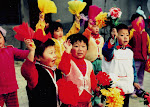 |
| Local Chinese youngsters perform a traditional lion dance. |
A couple of things brought home the difference between the old and the new this week.
I found it quite ironic that Chinese in the United States are teaching their children about their cultural heritage while in Beijing kids that age aren't interested in such cultural activities. They are too busy trying to become Westernized.
When I lived in Beijing, I used to listen for the beating of drums in the evenings and on weekends. It meant Chinese women were doing yanko dancing somewhere, and I'd go look for them. Mostly older Chinese women would dance around in a circle waving colorful fans and scarves while older men beat the rhythm on drums. It looked like a simple dance, until one time some women talked me into joining them. Whew! Two rounds and I was exhausted, yet these women did it for extended periods of time. One time I watched for 45 minutes, and there was no break, no one dropped out. I remember debates taking place because the young adults wanted the yanko dancing stopped because the drums were too noisy.
Then the other day China Daily ran an opinion piece by columnist Chen Weihua who had just returned from a visit to Mexico City. He detailed all the things Mexicans were doing to preserve their heritage and history, then contrasted it to Beijing and Shanghai where historical buildings are being bulldozed, all in the name of progress.
So which culture is going to survive?
Are you going to China?
If China is in your travel plans, check out my website, Cheryl's China, and feel free to email me if you have any questions.




